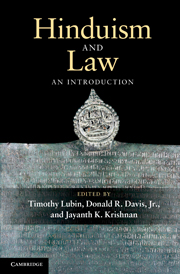Book contents
- Frontmatter
- Contents
- List of contributors
- Acknowledgements
- Chronology
- Abbreviations
- Map South Asia: political divisions c. 1860 and today
- Introduction
- Part I Hindu law
- Part II Law in ancient and medieval Hindu traditions
- Chapter 7 Hindu jurisprudence and scriptural hermeneutics
- Chapter 8 Indic conceptions of authority
- Chapter 9 Śūdradharma and legal treatments of caste
- Chapter 10 Law, literature, and the problem of politics in medieval India
- Chapter 11 Hindu law as performance
- Part III Law and modern Hinduism
- Glossary
- Bibliography
- Index
Chapter 8 - Indic conceptions of authority
Published online by Cambridge University Press: 05 June 2012
- Frontmatter
- Contents
- List of contributors
- Acknowledgements
- Chronology
- Abbreviations
- Map South Asia: political divisions c. 1860 and today
- Introduction
- Part I Hindu law
- Part II Law in ancient and medieval Hindu traditions
- Chapter 7 Hindu jurisprudence and scriptural hermeneutics
- Chapter 8 Indic conceptions of authority
- Chapter 9 Śūdradharma and legal treatments of caste
- Chapter 10 Law, literature, and the problem of politics in medieval India
- Chapter 11 Hindu law as performance
- Part III Law and modern Hinduism
- Glossary
- Bibliography
- Index
Summary
Introduction
The term “authority” is used to denote a variety of related but distinct notions in studies of law. The Euro-American philosophy of law contrasts “theoretical authority” (the capacity to define what one should know) – which I prefer to call “epistemic” authority – with “practical authority” (the capacity to provide a sufficient reason for others to act) (e.g., Finnis 1980, 2007; Raz 1986, 1990). Practical authority may be further broken down into a capacity to enjoin (to create a duty) and a capacity to permit (endow with a right or privilege), which includes a capacity to delegate similar authority to others, in other words to “authorize.” One should distinguish between the notions of de facto authority (which is backed only by the threat of force) (Thomas Hobbes, John Austin) and legitimate authority (which is recognized as morally obligatory by at least a significant portion of a society or an influential segment thereof) (Hart 1961). All forms of legitimate authority are delimited by jurisdiction: the geographic, political, bureaucratic, or situational range in which a given authority has force or is recognized.
This chapter identifies some of the main Indic concepts that are comparable to these notions, describing how they are presented in the available sources, and the religious and legal contexts in which they apply. Our primary Indian sources include early wisdom literature, ritual codes, compilations of precepts of dharma and the extensive medieval commentaries thereon, and similar material included in other forms of literature. The ideas articulated in these sources may be compared with the assumptions that seem to underlie references to authority in such legal documents as have survived from before the colonial period. Such documents take the form of inscriptions on stone and copper plates, formulary anthologies, and the few collections of documents on perishable materials that remain in archives.
- Type
- Chapter
- Information
- Hinduism and LawAn Introduction, pp. 137 - 153Publisher: Cambridge University PressPrint publication year: 2010
- 4
- Cited by



